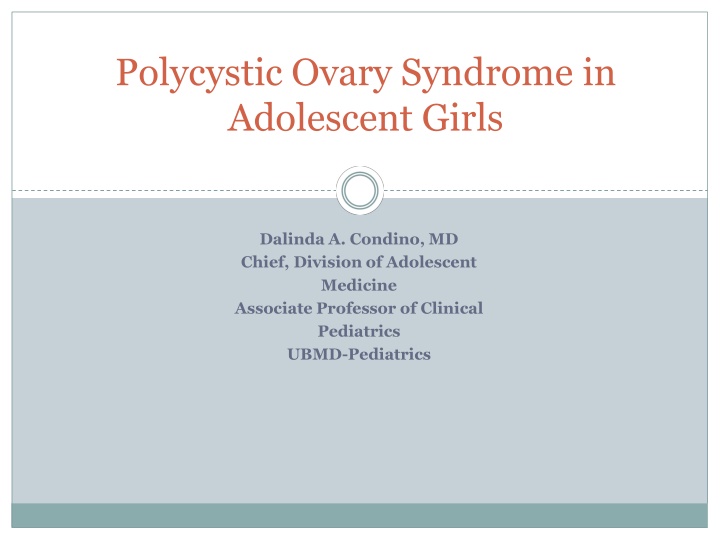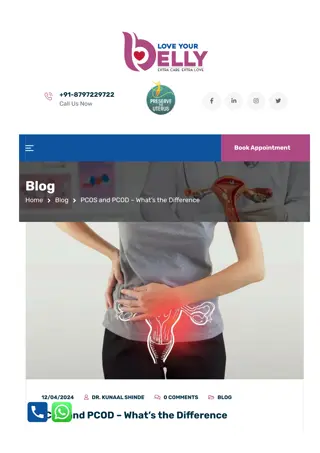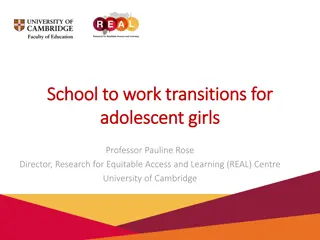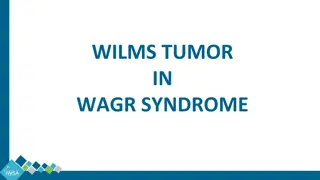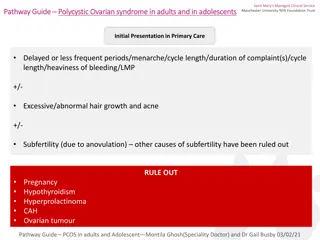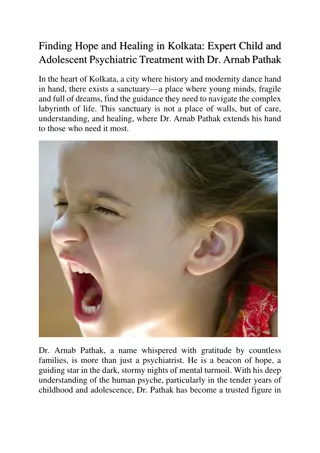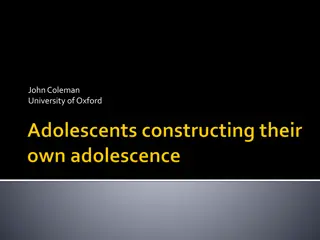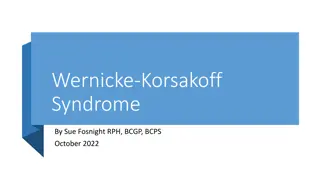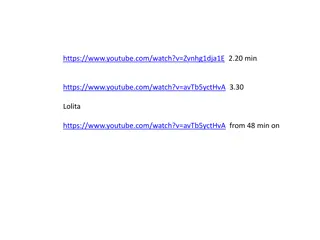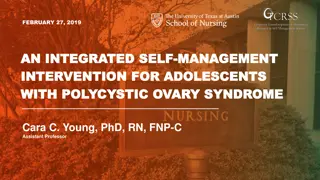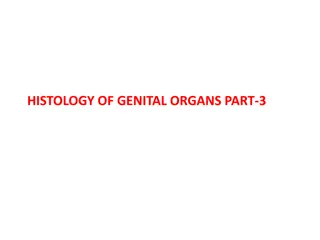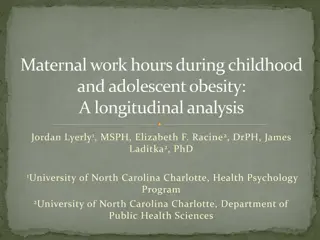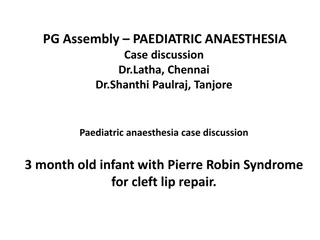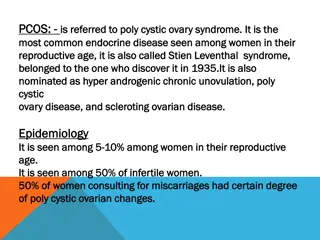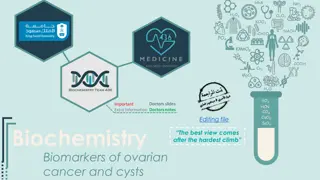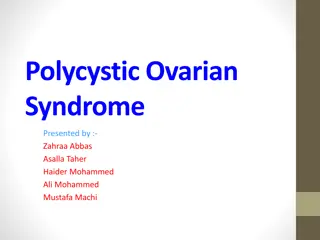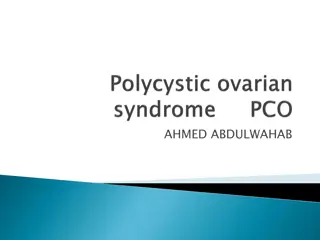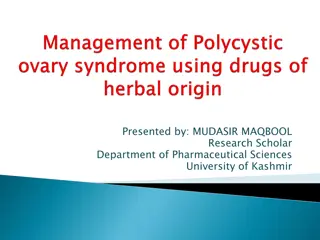Polycystic Ovary Syndrome in Adolescent Girls
Polycystic Ovary Syndrome (PCOS) is a common reproductive endocrine disorder affecting 5-10% of women. This article discusses the epidemiology, diagnostic criteria, clinical spectrum, and management strategies for PCOS in adolescent girls through two insightful cases. The cases highlight the varied presentations of PCOS in relation to fertility concerns, irregular periods, and physical activity. Understanding the nuances of PCOS in young females is crucial for early detection and effective treatment.
Download Presentation

Please find below an Image/Link to download the presentation.
The content on the website is provided AS IS for your information and personal use only. It may not be sold, licensed, or shared on other websites without obtaining consent from the author.If you encounter any issues during the download, it is possible that the publisher has removed the file from their server.
You are allowed to download the files provided on this website for personal or commercial use, subject to the condition that they are used lawfully. All files are the property of their respective owners.
The content on the website is provided AS IS for your information and personal use only. It may not be sold, licensed, or shared on other websites without obtaining consent from the author.
E N D
Presentation Transcript
Polycystic Ovary Syndrome in Adolescent Girls Dalinda A. Condino, MD Chief, Division of Adolescent Medicine Associate Professor of Clinical Pediatrics UBMD-Pediatrics
Disclosure I have no relevant financial relationships with the manufacturer(s) of any commercial product(s) and/or provider(s) of commercial services discussed in this CME activity. I intend to discuss off-label use of medication (metformin, oral contraceptive pills) in the context of standard PCOS treatment.
Objectives Understand the epidemiology and diagnostic criteria for PCOS Recognize the clinical spectrum and pathophysiology of androgen excess in adolescents Develop a management strategy for a PCOS- affected adolescent
Case 1 NW is an 18 year old female who presents for fertility concerns. She has had irregular periods since menarche. Her primary care providerprescribed birth control pills 3 yrs ago for contraception which she has not been taking. She is now concerned because she has not yet conceived after being off the pill for months. Her boyfriend of two years is ready to have children. On ROS she reports that she visits the salon weekly for hair removal, denies significant problems with acne, has an elevated cholesterol, and no other health problems. On exam she is well developed, Tanner V female with a BMI of 35, with AN, some pustules on her back, FG of 10, but exam is otherwise unremarkable.
Case 2 ST is a 19 year old female who presents to student health for a routine exam. She reports that she has not had a period in more than six months. She is an athlete who runs indoor and outdoor track and has been doing so since about the age of 15 years. She has also been a dancer since age 6 and prior to doing track danced semi-professionally. She was evaluated by her PMD for this and told that she wasn t having periods because she was too athletic and thin. FH and other PMH are non-contributory.She reports having a healthy diet and not limiting herself at all. She eats meals with her team and coaches who encourage lots of complex carbohydrates at mealtimes. She is an honor student, never been sexually active, but is dating. She has normal vitals, a BMI of 20, Tanner V breasts and pubic hair, and no other significant findings.
They Both Have PCOS! Obesity & classic features vs. Lean, healthy girl Difference = 10 years between their diagnoses and initiation of treatment
Polycystic Ovary Syndrome Common reproductive endocrine disorder 5-10% of women of reproductive age Strong family history/evidence of genetic basis Studies of first degree relatives of PCOS patients 24% mothers 32% sisters First described by Stein & Leventhal (1935) Seven women with amenorrhea, infertility, enlarged ovaries Follow report added hirsutism to observations Wedge resections (1930s) Hormonal management (1970s/80s) Stein IF, Leventhal NL Amenorrhea associatedwith bilateralpolycystic ovaries. Am J Obstet Gynecol, 1935; 29:181 191
Cost of PCOS The total cost of evaluating and providing care to reproductive-aged PCOS women in the United States Initial Evaluation Treating menstrual dysfunction (hormonal Providing infertility care PCOS-related diabetes Treating Hirsutism Total $93 Million (2.1%) $1.35 Billion (31%) $533 Milion (12.2%) $1.77 Billion (40.5%) $622 Million (14.2%) $ 4.36 Billion Azziz R, Marin C, Hoq L, BadamgaravE, Song P, Health Care-RelatedEconomic Burden of the Polycystic Ovary Syndromeduring the Reproductive Life Span, The Journalof Clinical Endocrinology & Metabolism,2005; 90(8):4650 4658
Quality of Life Subscale PCOS Healthy Comparisons 76.3 p General Health Perception Physical Functioning Family Activities Behavior 68.6 -7.7 .04 91.2 94.8 -4.1 .001 77.2 81.8 -6.0 .029 93.9 94.8 -2.9 .04 Mental Health 66.5 70.3 -3.8 .065 Change in Health/Yr 2.8 2.5 .26 .04 Trent M, et.al., Arch Ped Adol Med, 2002; 156: 1-5.
Where does it all start? Peri-menarchal period Abnormal physiological transition to puberty LH secretion Adrenal androgen production Body mass Insulin resistance Area of active research the cause is still unknown Focus Lutenizing hormone stimulation ovary GnRH secretion / gene expression Insulin involvement in androgen production
Clinical Features Menstrual Dysfunction Amenorrhea Oligomenorrhea Anovulation or oligoovulation Infertility Dysfunctional Uterine Bleeding Endometrial Hyperplasia
Hyperandrogenism Hirsutism (Ferriman-Gallwey Score > 8)1 Acne (Global Acne Score)2 Male pattern baldness/alopecia One or more elevated androgens: Testosterone (T), Free Testosterone, Dehydroepiandrosterone (DHEAS), Androstenedione 1) Ferriman D, Gallwey JD. Clinical assessment of body hair and growth in women J Clin Endocrinol Metab 1961; 121:1440 , 2) Doshi A, Zaheer A, Stiller M. A comparison of current acne grading systems and proposal of a novel system. (Reproduced with permission in: Emans SJ, et.al. Pediatric and Adolescent Gynecology, Lippincott, Williams, & Wilkins, 5thEd, 205, p305-307
Diagnostic Criteria Clinical Findings NIH Rotterdam, 2003 Androgen Excess Society, 2006/2009* Androgen Excess Required 2 of 3 Required Required Menstrual abnormality Required 1 of 2 Required PCO on ultrasound ACOG Practice Bulletin, 2009, 114 (4): 936-949,Azziz R. et.al. Fertil Steril, 2009, 91 (2): 456
Clitoromegaly Normal clitoral width<5mm Courtesy of Dr. Jean Emans, Adolescent Medicine Program, Boston Children s Hospital
Ovarian Pathology Classic Morphology: thickened, white capsule enlarged ovary with multiple small cysts at least 10 follicles, 2-8 mm in diameter Non-specificity: PCO in 92% women with idiopathic hirsutism 87% with oligomenorrhea 26% with amenorrhea 23% with reported regular cycles
Classic Ovarian Morphology String of Pearls Courtesy of Dr. Jean Emans, Adolescent Medicine Program, Boston Children s Hospital
Hyperinsulinemia PCOS pts: increased hyperinsulinemia and insulin resistance Clinical finding: Acanthosis Nigricans/Obesity Insulin: augments ovarian androgen response to LH Cytochrome 450c17alpha enzyme activity increased Involvement of IGFs Clinical improvement after Metformin Nestler et.al, NEJM 1996, 333:617-623
Differential Diagnosis PCOS Idiopathic Hirsutism Late-Onset CAH Drugs: steroids, anticonvulsants Cushing syndrome/disease Ovarian or adrenal tumors
History Virilization: deepening of the voice, temporal recession, increased muscle mass, clitoromegaly Hirsutism (time course, distribution) Acne Menstrual History Acanthosis Nigricans History of premature adrenarche Family History
Physical Examination Height, weight, vital signs Ferriman-Gallwey Score Acanthosis nigricans Acne Male pattern balding Upper body muscle mass Galactorrhea Clitoromegaly Ovarian masses
Laboratory Studies Goals: To rule out adrenal or ovarian tumor To assess severity of androgen excess To evaluate source of hyperandrogenism Ovarian ( Free and total testosterone) Adrenal (DHEA-S) Additional supportive labs : LH FSH (Rule Out Ovarian Failure) 17-OHP (Early AM) Lipid profile Fasting Glucose/2hour OGTT
Source of Androgen Interpretation of Labs Adrenal Cortex Ovary Peripheral Conversion of Precursors ~50% Testosterone ~25% ~25% Androstendione 50% 50% --- DHEA 90% 10% --- DHEA-S 100% --- --- Emans SJ, et.al. Pediatric and adolescent gynecology, 5thed. Philadelphia: Lippincott, Williams,Wilkins;2005: 301
Treatment Goals Hormonal suppression to lower ovarian androgen levels Improve menstrual irregularity Prevent endometrial hyperplasia Improve clinical findings affecting appearance (hirsutism and acne) Increase insulin sensitivity Prevent long-term complications
Oral Contraceptives and PCOS Decrease LH levels and decrease androgen synthesis Increase SHBG levels, increase T binding, and decrease free T Inhibit 5 alpha-reductase which decreases conversion of T to DHT (active androgen) Treat early
Progestin Only Therapy Regulates menses Lessens risk of endometrial cancer Medroxyprogesterone 10 mg for 12-14 days every 1-3 months Progestin only pills may not achieve menstrual regulation
Managing Hirsutism & Acne Hirsutism &Acne Courtesy of Dr. Jean Emans, Adolescent Medicine Program, Boston Children s Hospital
Temporary Methods Method Action Side Effects Bleaching 6% peroxide bleaches hair Irritation, ineffective, allergic reactions, syncope if persulfate used Shaving Mechanical cutting of hair Quick growth, stubble, irritation Chemical Depilatory Dissolves hair shaft by reduction of disulfide bonds Irritation, allergic/contact dermatitis, strong odor Tweezing Extraction of hair shaft Pain, hyperpigmentaton, scar, folliculitis Waxing Uniform extraction of hair Thermal burns, allergic/contact dermatitis, folliculitis, irritation, scarring
Permanent Methods Method Action Comments Electrolysis Low flow current causes chemical reaction destroying hair follicle Slow (1 minute per hair) Thermolysis High frequency current destroys hair follicle Faster (seconds per hair) Laser Laser light targets melanin in follicle causing thermal injury Thermal injury restricted to follicle Treatment of large areas with fewer side effects Traditional techniques cause significant side effects on darker skin
Laser Nd: Yag felt to be safest Deeper penetration Less absorption by epidermal melanin Newer Technique using longer-wavelength diode laser light effective in darker skinned patients Requires multiple visits to dermatologist Expensive BattleEF, Soden CE. Use of Lasersin DarkerSkin Types, Seminars on CutaneousMedicine and Surgery, 2009; 28:130-140
Potential Laser Side Effects Courtesy: Dr. Eliot F. Battle, Jr , CulturaCosmetic Dermatology & Laser Center/ Department of Dermatology Howard UniversityHospital, Washington, DC
Laser Hair Removal: Safe and Highly Effective 2 years after last treatment Courtesy: Dr. Eliot F. Battle, Jr , CulturaCosmetic Dermatology & Laser Center/Howard University Hospital, Washington, DC
Improvement in Skin Tone/Texture 1 year after 12 Treatments 40 ms 30 J/cm2 Courtesy: Dr. Eliot F. Battle, Jr , CulturaCosmetic Dermatology & Laser Center/Howard University Hospital, Washington, DC
Hormonal Treatment of Hirsutism Oral contraceptives Estrogens increase SHBG, decreasing free T Suppress gonadotropin dependent ovarian androgens Suppress adrenal androgens Cyclic versus continuous pills (QD or 84 days and 7 days off) Patches and Rings Limited research/clinical use documented in literature Theoretically should be considered for treatment Adherence
Hirsutism Anti-androgens (e.g. spironolactone) to reduce hair diameter (41% at 12 months) best used with OCPs 50-100 mg bid Potential Side-effects: hypotension, lethargy, urinary frequency, hyperkalemia, nausea O Brien RC, Cooper ME, MurrayRM, et.al. Comparison of the sequential cyproterone acetate/estrogenvs. spironolactone /oral contraceptive in the treatment of hirsutism, J Clin Endocrinol Metab 1991;72: 1008.**
What about OCPs with Drosperinone? Observational study of women with PCOS Determine if clinical and biochemical features of PCOS are ameliorated by Yasmin 17 patients treated x 6 months Results: 76% good cycle control no change in BMI increased insulin/triglycerides decreased testosterone/increased SHBG no change in hirsutism clinically The anti-androgen contained in Yasmin just percentage of the spironolactone prescribed for PCOS Palen-Singh M, et.al. An observational study of Yasmin in the management of women with polycystic ovary syndrome.Fam Plann Reprod Health Care. 2004 Jul;30(3):163-5. is
Hirsutism GnRH analogues Estrogen addback needed to preserve bone density Prednisone for late onset CAH (21OH deficiency) Treatment with OCs appears to be equally effective
Topical: Eflornithine 13.9% Cream Irreversible inhibitor of ornithine decarboxylase, an enzyme which mediates cell division and growth in hair follicles Side-effects: burning, folliculitis (more likely if applied to shaved skin) Need to continue mechanical hair removal methods If discontinued hair growth will resume
Acne Topical or oral medications depending on the type of acne Oral contraceptive pills reduce the free and total testosterone improving acne
Acanthosis Nigricans Treatment guided by its cause Weight loss and treatment of underlying disorders Topical: retinoic acid, corticosteroids, keratolytics Oral: isotretinoin, ketoconazole
Insulin Resistance and Obesity Weight loss if obese Reduces peripheral estrogen production Reduces cardiovascular risk Reduces insulin resistance and suppresses ovarian androgen production Methods Exercise Decreased Caloric Intake Dietary modification Medications Metformin Orlistat Tang T, et.al. Combined lifestylemodification and metformin in obese patientswith polycystic ovary syndrome. A randomized placebo-controlled, double blind multicentrestudy, Human Reproduction, 2006; 21 (1): 80-89 Jayapogopal V, et.al.Orlistatis as beneficial as metformin in the treatment of polycystic ovary syndrome, J Clin Endocrinol Metab, 2005; 729-733.
Insulin Sensitizing Agents Metformin decreases androgens, decreased weight slightly resumption of menses in 68-96% ovulation in 30-40%, ?effect on hirsutism Dosing: 500 mg TID 850 mg BID Extended Release (multiple formulations 500mg, then increase to 1-2g /day for most formulations) side-effects - GI (flatulence, diarrhea)
Glucose Intolerance Study of 254 women with PCOS, 0 and 2 hr post 75 gm glucose: 31% impaired glucose tolerance 7.5% diabetes In non-obese women: 10.3% IGT and 1.5% diabetes Fasting glucose poor predictor of IGT Legro, J Clin Metab Endo 1999
Glucose Intolerance in Adolescents with PCOS Study of 27 adolescents with PCOS 8/27 had IGT; 1/27 type 2 DM Fasting blood glucose abnormal in 2/8 Glucose/Insulin ratio <4.5 in 15/18 Palmert J Clin Endo Metab, 2002
Risk of Progression to Diabetes 6.2 year follow-up Normal Glucose tolerance test at baseline 5/54 (9%) developed IGT 4/54 (8%) DM BMI at baseline significant predictor of later adverse glucose tolerance Norman, Human Reproduction, 2001
Treatment Manage urgent clinical needs Treat PCOS and all comorbidities Encourage lifestyle changes (nutrition and exercise) Metformin Glycemic control Improves insulin resistance Improves reproductive function
Case 3 JS is a 15 year old who presents with classic findings of PCOS: menstrual irregularity, clinical evidence of androgen excess (hirsutism & acne), and morbid obesity with signs of insulin resistance. Basic labs were obtained, but due to a lab error, liver function tests obtained instead of androgens. Labs: AST: 94, ALT: 97 ALK 124 Chol 226 Glucose 110 TSH 1.72, T4 1.3, Insulin 156 Repeat labs show elevated androgens, repeat glucose NL, Repeat LFTS AST 139, ALT 176, Negative screening for infectious hepatitis Diagnosis? What do you do now?
Additional Labs Ultrasound: Liver is large and shows echogenicity consistent with fatty infiltrate. No evidence of biliary obstruction. Large spleen, Kidneys nl. Pancreas not seen. Referred to GI Patient non-adherent to recommendations for GI follow-up, dietary change, metformin. Later developed type 2 DM Eventually went to GI appointment: Liver biopsy consistent with steatohepatitis
Non-Alcoholic Fatty Liver Disease (NAFLD)& Steatohepatitis (NASH) NAFLD Inflammation NASH Associated with metabolic syndrome Obesity Hypertension Increased cholesterol Insulin resistance Treatment No standard medical treatment Avoidance of toxic substances (ETOH, Medications) Weight Management Diabetes control Cholesterol control Caution with statins, but research promising Zamor Curr Opin Cardiol. 2011 Jul;26(4):338-412011; Bugianesi, E.Am J Gastroenterology, 2005, 100: 1082 NIDDK Information sheet: http://digestive.niddk.nih.gov/ddiseases/pubs/nash/ (last accessed 11/15/11)
